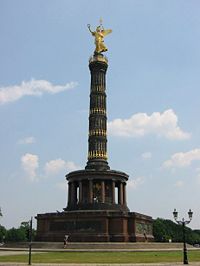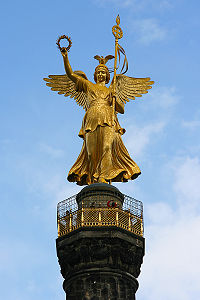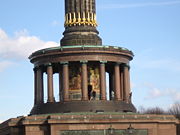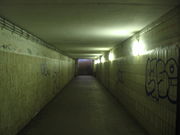Berlin Victory Column





The Victory Column (German: Siegessäule) is a famous monument in Berlin, Germany. Designed by Heinrich Strack after 1864 to commemorate the Prussian victory in the Danish-Prussian War, by the time it was inaugurated on 2 September 1873, Prussia had also defeated Austria in the Austro-Prussian War (1866) and France in the Franco-Prussian War (1870–71), giving the statue a new purpose. Different from the original plans, these later victories in the so-called unification wars inspired the addition of the bronze sculpture of Victoria, 8.3 meters high and weighing 35 tonnes, designed by Friedrich Drake. Berliners, with their fondness for giving nicknames to famous buildings, call the statue Goldelse, meaning something like "Golden Lizzy".[1]
The Victory Column is a major tourist attraction to the city of Berlin and opens daily: 9:30 a.m. – 6:30 p.m. (April – October), and 9:30 a.m. – 5:30 p.m. (November – March).
Contents |
History, design, and influences
Design and dimensions
Built on a base of polished red granite, the column sits on a hall of pillars with a glass mosaic designed by Anton von Werner.
The column itself consists of four solid blocks of sandstone, three of which are decorated by cannon barrels captured from the enemies of the aforementioned three wars. The fourth ring is decorated with golden garlands and was added in 1938–39 when the column was moved to its present location.
The relief decoration had to be removed at the request of the French forces in 1945, probably to prevent Germans from being reminded of former victories, especially the defeat of the French in 1871. It was restored for the 750th anniversary of Berlin in 1987 by the French president at that time, François Mitterrand. However, several sections remain in France.
Designers and architects
Werner designed the original hall of pillars with a glass mosaic.
The foundation is decorated with four bronze reliefs showing the three wars and the victorious marching of the troops into Berlin. They were created by four Berlin sculptors:
- Moritz Schulz (1825–1904)
- Karl Keil (1838–89)
- Alexander Calandrelli (1834–1903)
- and Albert Wolff (1814–92)
Location and relocations
The Victory Column originally stood in Königsplatz (now Platz der Republik), at the end of the Siegesallee (Victory Avenue). As part of the preparation of the monumental plans to redesign Berlin into Welthauptstadt Germania, in 1939, the Nazis relocated the column to its present site at the Großer Stern (Great Star), a large intersection on the city axis that leads from the former Berliner Stadtschloss (Berlin City Palace) through the Brandenburg Gate to the western parts of the city. At the same time, the column was augmented by another 7.5 meters, giving it its present height of 70 meters. The monument survived World War II without much damage. The relocation of the monument probably saved it from destruction, as its old site in front of the Reichstag was destroyed. Without a British-American veto, the French would have dynamited the monument after the war.
Surrounded by a heavily trafficked street circle, the column is accessible to pedestrians through four tunnels, built in 1941 to plans by Albert Speer. Via a steep spiral staircase of 285 steps, the physically fit may, for a small fee, climb almost to the top of the column, to just under the statue and take-in the spectacular views over the Tiergarten.
Cultural references
The column is featured in Wim Wenders' film Wings of Desire as being a place where angels congregate.[2] The golden statue atop the column was featured in the music video to U2's "Stay (Faraway, So Close!)" and inspired Paul van Dyk's 1998 trance music hit, "For an Angel"; the column was also featured in his music video during the Love Parade in 1998. "El Ángel" in Mexico City bears a more than passing resemblance to the Berlin victory column, while both echo the earlier examples of the victory column crowned by an angel, notably the Alexander Column in Saint Petersburg.
The Victory Column served as the location for Barack Obama's speech in Berlin during his visit to Germany on July 24, 2008. Obama talked about cooperation between the United States and Europe in the speech and ended his speech with these lines: "With an eye toward the future, with resolve in our hearts, let us remember this history, and answer our destiny, and remake the world once again." [2][3]
References
- ↑ Berlin Tourist Information - Tiergarten
- ↑ 2.0 2.1 Donahue, Patrick (2008-07-18). "Obama to Speak at Berlin Victory Column, Berliner Zeitung Says", Bloomberg. Retrieved on 2008-07-21.
- ↑ "Barack Obama spricht am Großen Stern" (in German), Berliner Zeitung (2008-07-18). Retrieved on 2008-07-21.
External links
- Siegessäule in the Structurae database